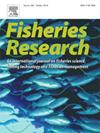耳石稳定同位素强调了当地育苗区作为西印度洋黄鳍金枪鱼(Thunnus albacares)渔业新成员来源的重要性
IF 2.2
2区 农林科学
Q2 FISHERIES
引用次数: 0
摘要
黄鳍金枪鱼(Thunnus albacares)是世界上第二大金枪鱼渔场,在印度洋,它被过度捕捞并受到过度捕捞。这种情况对渔业管理提出了重大挑战,需要采取有效措施重建鱼群,然后将其维持在可持续的水平。印度洋金枪鱼委员会(IOTC)目前在印度洋的种群评估中假定黄鳍金枪鱼只有一个种群。然而,不同产卵成分对总捕获量的相对贡献,以及来自不同生产区的个体在印度洋的黄鳍金枪鱼混合率的程度仍然未知。本研究利用位于印度洋西部(FAO区域51)和东部(FAO区域57)80ºE两侧幼崽区黄鳍金枪鱼的耳石核氧和碳稳定同位素组成(δ18O和δ13C),建立了同位素特征参考基线。然后,使用混合种群计划(HISEA)和随机森林(RF)分配方法,通过将其耳石核心值与基线值进行比较,预测从西印度洋四个渔区(巴基斯坦近海、塞舌尔、留尼汪和南非)捕获的亚成年和成年黄鳍金枪鱼最可能的来源(西部或东部)。两种方法都表明,西印度洋渔业主要由西源鱼组成(>;95 %)。我们还发现一些个体的耳石同位素特征与基线中可用的任何一个样本都不相同。我们模拟了一个替代基线组,由平均和标准差δ13C和δ18O值高于原始基线的最大范围的个体组成。然后,我们使用RF再次推断混合样本中最有可能的鱼类来源,考虑3种可能的来源(西部,东部,替代)。大约三分之一的样本被分配到替代组,这可能表明它们在地理或时间方面与原始基线中所代表的起源不同。西印度洋黄鳍金枪鱼耳石稳定同位素组成的研究结果,可以超越目前海洋盆地单一种群的假设,更全面地了解该物种的空间结构和连通性。本文章由计算机程序翻译,如有差异,请以英文原文为准。
Otolith stable isotopes highlight the importance of local nursery areas as the origin of recruits to yellowfin tuna (Thunnus albacares) fisheries in the western Indian Ocean
Yellowfin tuna (Thunnus albacares) supports the second largest tuna fishery worldwide, and in the Indian Ocean, it is overfished and subject to overfishing. This situation presents a significant challenge to fisheries management, requiring effective measures to rebuild and then maintain the stock at sustainable levels. A single stock of yellowfin is currently assumed by the Indian Ocean Tuna Commission (IOTC) for stock assessments in the Indian Ocean. However, the relative contribution of different spawning components to the total catches, and the degree of mixing rates of yellowfin tuna in the Indian Ocean by individuals from different production zones, are still unknown. This study uses otolith core oxygen and carbon stable isotope composition (δ18O and δ13C) of young-of-the-year yellowfin tuna from nursery areas located in the western (FAO Area 51) and eastern (FAO area 57) Indian Ocean, either side of 80 ºE, to establish a reference baseline of isotopic signatures. Then, a mixed population program (HISEA) and Random Forest (RF) assignment approaches were used to predict the most likely origin (west or east) of sub-adult and adult yellowfin tuna captured from four fishery areas of the western Indian Ocean (offshore Pakistan, Seychelles, Reunion, and South Africa) by comparing their otolith core values to that of the baseline. Both approaches show that the western Indian Ocean fisheries are mainly composed of west origin fish (> 95 %). We also found some individuals with an otolith isotopic signature that was not characteristic of either of the samples available in the baseline. We simulated an alternative baseline group formed by individuals with mean and standard deviation δ13C and δ18O values above the maximum ranges of the original baseline. We then used RF to infer again the most likely origin of fish in the mixed sample considering 3 possible sources (west, east, alternative). About one third of the samples were assigned to the alternative group, possibly indicating that they differ in geographical or temporal terms with the origins represented in the original baseline. Findings of otolith stable isotope composition of yellowfin tuna in the western Indian Ocean can provide a more comprehensive understanding of the species’ spatial structure and connectivity beyond the current assumption of an ocean basin single stock.
求助全文
通过发布文献求助,成功后即可免费获取论文全文。
去求助
来源期刊

Fisheries Research
农林科学-渔业
CiteScore
4.50
自引率
16.70%
发文量
294
审稿时长
15 weeks
期刊介绍:
This journal provides an international forum for the publication of papers in the areas of fisheries science, fishing technology, fisheries management and relevant socio-economics. The scope covers fisheries in salt, brackish and freshwater systems, and all aspects of associated ecology, environmental aspects of fisheries, and economics. Both theoretical and practical papers are acceptable, including laboratory and field experimental studies relevant to fisheries. Papers on the conservation of exploitable living resources are welcome. Review and Viewpoint articles are also published. As the specified areas inevitably impinge on and interrelate with each other, the approach of the journal is multidisciplinary, and authors are encouraged to emphasise the relevance of their own work to that of other disciplines. The journal is intended for fisheries scientists, biological oceanographers, gear technologists, economists, managers, administrators, policy makers and legislators.
 求助内容:
求助内容: 应助结果提醒方式:
应助结果提醒方式:


